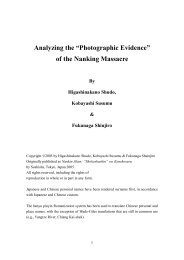The Senkaku Islands Constitute an Intrinsic Part of Japan
The Senkaku Islands Constitute an Intrinsic Part of Japan
The Senkaku Islands Constitute an Intrinsic Part of Japan
You also want an ePaper? Increase the reach of your titles
YUMPU automatically turns print PDFs into web optimized ePapers that Google loves.
arguments to the grounds for China‟s claims in 1) to 4) <strong>of</strong> Section 5, as the counter<br />
arguments cited there are also the counter arguments to Inoue‟s points.<br />
� Inoue argues that it was clear from the records <strong>of</strong> imperial missions to the Ryukyu<br />
Kingdom that the Chinese <strong>an</strong>d Ryukyu<strong>an</strong>s knew that Kuba Isl<strong>an</strong>d lay near the<br />
border <strong>of</strong> the Ryukyu Kingdom, <strong>an</strong>d isl<strong>an</strong>ds lying west <strong>of</strong> Sekisho (Taishojima<br />
Isl<strong>an</strong>d) were not the territories <strong>of</strong> Ryukyu. But, it does not follow that everything<br />
lying west <strong>of</strong> Sekisho would necessarily be the territory <strong>of</strong> China. It is true that<br />
the isl<strong>an</strong>ds west <strong>of</strong> Sekisho were not the territory <strong>of</strong> Ryukyu, because they were<br />
not inhabited, not to mention being places where boats could not l<strong>an</strong>d. <strong>The</strong>se<br />
circumst<strong>an</strong>ces were the same for the Chinese. For Inoue, it is as if <strong>an</strong>y l<strong>an</strong>d<br />
appearing on maps belonged to China except the territories <strong>of</strong> Ryukyu, or<br />
territories <strong>of</strong> <strong>an</strong>other country. This is laughable, exposing China‟s view <strong>of</strong><br />
domin<strong>an</strong>ce <strong>an</strong>d its Sinocentric imperialism. Inoue cited Chen K<strong>an</strong> „s Shi Liu-ch'iu<br />
Lu as evidence, in which Little Ryukyu (Taiw<strong>an</strong>) appears on navigational routes.<br />
But, Inoue‟s argument disintegrates with the fact that Taiw<strong>an</strong> was not included as<br />
part <strong>of</strong> the Ming Dynasty‟s territory.<br />
� Inoue points out that the area between the Sekisho <strong>an</strong>d Kuba isl<strong>an</strong>ds was referred<br />
to as “Jiao” (Chinese: 郊, me<strong>an</strong>ing outskirts), the “border between inside <strong>an</strong>d<br />
outside,” in the records <strong>of</strong> the Qing imperial envoy W<strong>an</strong>g Ji, <strong>an</strong>d was a place<br />
where envoys prayed for a safe journey. Inoue misconstrues this to suit his<br />
argument. <strong>The</strong> fact is, the records do not suggest territorial implications, rather,<br />
they imply a successful crossing <strong>of</strong> the most treacherous waters (Jiao) promising<br />
the safe reach <strong>of</strong> Kuba Isl<strong>an</strong>d with its hum<strong>an</strong> habitation. Indeed, because the<br />
<strong>Senkaku</strong>s lie in a solitary location in the dist<strong>an</strong>t sea, even the Ryukyu people<br />
could not go ashore, let alone a Chinese approach <strong>of</strong> the isl<strong>an</strong>ds. Furthermore, the<br />
Qing Dynasty, which incorporated Taiw<strong>an</strong> into its territory, did not add the<br />
<strong>Senkaku</strong> <strong>Isl<strong>an</strong>ds</strong> to its territorial maps. Finally, that mention <strong>of</strong> the <strong>Senkaku</strong><br />
<strong>Isl<strong>an</strong>ds</strong> was not found <strong>an</strong>ywhere in the Qing Huidi<strong>an</strong> (Chinese: 清会典), the<br />
statutory encyclopedias <strong>of</strong> the Qing Dynasty, is conclusive evidence that they<br />
were not considered to be part <strong>of</strong> Chinese territory.<br />
� Inoue claims that in the Zhouhai Tubi<strong>an</strong> (Chinese: 籌海図編) issued by Hu<br />
Songxi<strong>an</strong> in 1556, the isl<strong>an</strong>ds <strong>of</strong> Keiros<strong>an</strong> (Chinese:雛籠山) ,Uotsurijimakyou<br />
(Chinese:釣魚島興), Kobins<strong>an</strong> (Chinese:化瓶山), Kobis<strong>an</strong> (Chinese:黄尾山),<br />
R<strong>an</strong>kakus<strong>an</strong> (Chinese:欄攪山), <strong>an</strong>d Sekisho (Chinese:赤興) were depicted as<br />
<strong>of</strong>fshore isl<strong>an</strong>ds <strong>of</strong> the coastal cities <strong>of</strong> Luoyu<strong>an</strong> (Chinese:羅源) <strong>an</strong>d Ningde<br />
(Chinese:寧徳) in Fuji<strong>an</strong> province, indicating that these isl<strong>an</strong>ds were part <strong>of</strong><br />
Chinese territory. As discussed in counter argument 4) <strong>of</strong> Chapter 5, the map was<br />
made for the purpose <strong>of</strong> Jap<strong>an</strong>ese pirate eradication following a Ming Dynasty<br />
imperial order. <strong>The</strong> map itself was sloppily drafted as shown on page XX, for<br />
example, Uotsuri/Daioyu Isl<strong>an</strong>d is, in reality, 400 km away from Fuji<strong>an</strong>, but is<br />
placed on the map next to Keiros<strong>an</strong> which is much closer to Fuji<strong>an</strong>, <strong>an</strong>d Kobins<strong>an</strong>,<br />
in reality, is closer to Keelung <strong>an</strong>d not located on the Uotsuri/Daioyu Isl<strong>an</strong>d side,<br />
28












